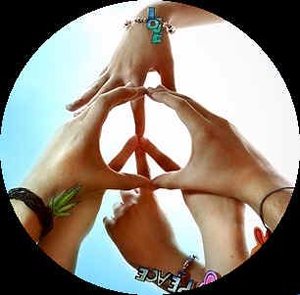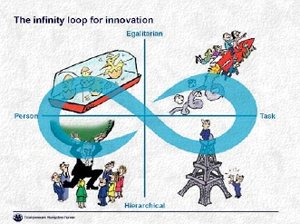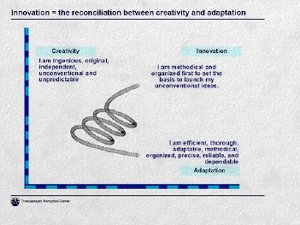In today’s connected, fast-paced world, transcultural competence is more important than it already was. Leaders and change makers must be able to collaborate around the globe, while they also create and foster a culture of innovation. Change and innovation, once an extraordinary event in an organization’s life cycle, are currently more like “business as usual”.
How to increase your transcultural competence and be more innovative? Dr. Fons Trompenaars, a Dutch-French organizational theorist, management consultant, and author in the field of cross-cultural communication, who developed the 7 Dimension of Culture model for looking at national culture differences, presents at the conference of the International Society for Organization Development and Change (ISODC).
From Bipolar to Connected Thinking
 “Diversity is beautiful and dramatic if you don’t manage it well”, Trompenaars begins. “But we’re not well prepared for diversity. We seem to prefer bipolar thinking – we create models that represent the world on mutually exclusive polarities. Take the Myers-Briggs Type Indicator (MBTI) – the famous personality assessment. Isn’t that too bipolar to be true? Why would thinking occur at the cost of feeling? Our heroes score high on both thinking and feeling…”
“Diversity is beautiful and dramatic if you don’t manage it well”, Trompenaars begins. “But we’re not well prepared for diversity. We seem to prefer bipolar thinking – we create models that represent the world on mutually exclusive polarities. Take the Myers-Briggs Type Indicator (MBTI) – the famous personality assessment. Isn’t that too bipolar to be true? Why would thinking occur at the cost of feeling? Our heroes score high on both thinking and feeling…”
“Another example: why do we see these waves of centralization or decentralization? Decentralization can only be done when you’re centralized and vice versa.”
Trompenaars’ long-term partner, Charles Hampden-Turner, a British management philosopher, and senior research associate at the Judge Business School at the University of Cambridge, offered an appealing vision of working with value differences. “We use many bipolar tools in business and science. We also see that any value that’s disconnected from its opponent turns into a pathology. Rather than a tale of two paradigms, we need both sides of those scales. So, why not combine them?” It is dilemma reconciliation, as Fons and Charles suggest, that creates change and an innovative, resilient culture.
“Fifteen years ago – a leader needed courage. But if you have courage without caution – you’re an idiot. You need to balance and reconcile competing values”, explains Trompenaars.
“Take this example of a car: what is its value? The car will get you somewhere, so you might value speed and safety. You need both to enjoy the car. If you take off wheels – it gains safety but loses speed. If you double the engine, you win speed but lose safety…”
It’s funny and true. We need the whole car – and reconcile dilemmas.
Reconcile dilemmas
Trompenaars gives this definition: “To innovate is to combine values that are not easily joined – therefore scarce – therefore profitable. Innovative leaders have the propensity and the competence to help organizations and their teams reconcile dilemmas for sustainable innovation.”
He stresses we need to redesign our bipolar models that make us oscillate from one extreme to another. “Banks gave too many loans, now  they don’t give loans anymore – we need a model that connects opposites.”
they don’t give loans anymore – we need a model that connects opposites.”
Our bipolar thinking created five exaggerations for organizations over the past decades: they either focused on corporate effectiveness – employee development – satisfaction of clients – shareholder value – or, contributions to society. Neither of them reconciled dilemmas and was well-balanced.
A good example of organizations working at reconciling dilemmas is HSBC as you can see in their tagline: “The world’s local bank” – where they combine global and local in a mutually enhancing way. Another example of looking at multiple values and viewpoints is the Japanese way of thinking. The Japanese don’t have a word for objectivity. They recognize something like “kyak” – the outsider’s viewpoint, and “shuk” – the insider’s viewpoint. Trompenaars explains: “A different point of view is simply the view from a place where you’re not. It may reveal something that lifts you from bipolar or singular thinking.”
Trompenaars says we need to Recognize – increase awareness, Respect – appreciate cultural differences, Reconcile – resolve cultural differences, and, Realize and Root – implement reconciling actions. That’s how we can work together. “Inclusion is about what you share, diversity is what you don’t share – and the difference is made by leadership. You need them both. A diverse team might hinder an average leader, but a great leader can create innovation from this.”
 We all know competing values and dilemmas from experience. Take the issue of saving your relationship while you provide honest feedback. Each culture has their way of reconciling dilemmas.
We all know competing values and dilemmas from experience. Take the issue of saving your relationship while you provide honest feedback. Each culture has their way of reconciling dilemmas.
A Dutch boy who’s in love will say he likes the ugly dress his fiancée just bought. He acts more Japanese at the onset, saying “yes” to the relationship first. But after some time in the bar – he might admit he thinks the dress is ugly.
The Dutch in general start with (sometimes blunt) feedback and then try to repair the relationship afterward in the bar. While in Japan, you start with the relationship – and give feedback later on, in the bar. No matter what your preferred order is, you need both values – so you need to reconcile them.
By the way – how to discern a dilemma? A problem can be solved with more money and time – while a dilemma needs another mindset. It’s like Einstein said: You need to find a solution on another level.
Trompenaars continues: “Culture is a dynamic process of solving dilemmas in the areas of human relationships, time, and nature. National culture affects corporate culture affects teams… What you do, is your culture. And that  becomes more and more a challenge since we are living everywhere – together with different backgrounds.”
becomes more and more a challenge since we are living everywhere – together with different backgrounds.”
The Car Dilemma
We, the audience, engage in a Car Dilemma. Our friend has caused an accident driving too fast in his car and hit a pedestrian. Our friend is summoned to court, as are we, as a witness to testify about his driving speed. What do we do? Can he expect us to lie for the sake of friendship? Do we value truth most of all and do we testify against his interests?
The answer depends on your culture. What’s more, whatever answer we choose, we can both claim that we value Integrity as a super value. Integrity could mean: helping our friend or – telling the truth.
The problem is the question – you cannot find integrity on a linear scale. Integrity is finding wholeness by integrating opposites – so we don’t settle for half the logic. In reality, we’ll try to bridge the contradiction. We’ll try to find criteria and conditions. We’ll talk about friendship, entice our friends to own their actions and help them in any other way – even, visit them in jail..
 Welcome to reality, that is both yin and yang. Instead of: or/or.
Welcome to reality, that is both yin and yang. Instead of: or/or.
Trompenaars shows interesting slides of which competing values different countries tend to emphasize: universal versus particular, individual versus collective, neutral versus affective etc. We judge from our own cultural point of view: “The USA are corrupt because they don’t help their friends after a car accident”, or: “Korea is corrupt because they don’t tell the truth when testifying in court”.
Innovation is the reconciliation between creativity and adaptation, states Trompenaars. Interesting enough, this looks just like the Competing Values Framework by Cameron & Quinn that organizations need to balance to create a healthy organizational culture. Culture types in the CVF can be innovative versus efficient, people versus results-oriented.
Trompenaars culture model is slightly different but just as recognizable: he distinguishes four corporate cultures and  you need them all to create innovation. You have to make the movement of a figure 8 to stir innovation.
you need them all to create innovation. You have to make the movement of a figure 8 to stir innovation.
Personally, I think that reconciling dilemmas as Trompenaars explains, is exactly what the world and workplaces need to become un-stuck and move away from conflict. We must foster diversity and respect and collaborate and innovate to solve the challenges of our time. If we can learn from these dilemmas – learn how to have a dialogue and solve them – and benefit from Trompenaars’ research and model – we could develop our organizations and ourselves further.
Fons Trompenaars can be reached via Trompenaars Hampden-Turner.
• Where and when do you use bipolar thinking?
• How can you reconcile your current dilemmas?
• See, how this makes you more innovative…?
• How would you solve the Car Dilemma in your national culture?
• What are dilemmas in your workplace?
• How are they solved – if at all? What does that tell you about your current workplace culture?
• Take note of the dilemmas you face in the next weeks – and how you solve them. You will become more aware of your value hierarchy!

2 Responses
Hello – Thank you for the excellent article. Maybe I am missing something, but does this idea not connect to Polarity Management from Dr. Barry Johnson? Seems so. Good to know there is more theory and thinking in this area. Wondering if Dr. Johnson has connection to this work too?
Hi Mike, I couldn’t tell you as I don’t know Johnson’s work. Time to check it out! Thanks for your comment: it’s always good to find connections between different models and theories as it helps to deepen our understanding.